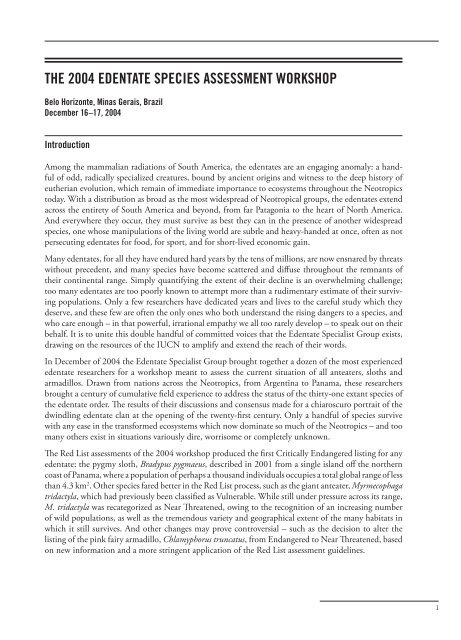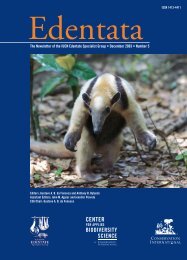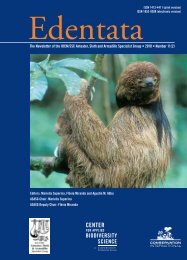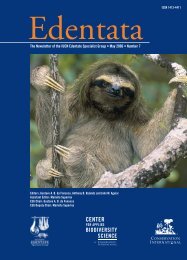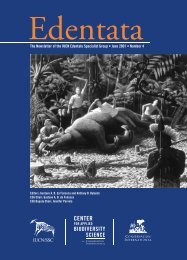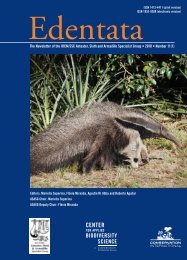Edentata 6 - Anteater, Sloth & Armadillo Specialist Group
Edentata 6 - Anteater, Sloth & Armadillo Specialist Group
Edentata 6 - Anteater, Sloth & Armadillo Specialist Group
You also want an ePaper? Increase the reach of your titles
YUMPU automatically turns print PDFs into web optimized ePapers that Google loves.
THE 2004 EDENTATE SPECIES ASSESSMENT WORKSHOP<br />
Belo Horizonte, Minas Gerais, Brazil<br />
December 16–17, 2004<br />
Introduction<br />
Among the mammalian radiations of South America, the edentates are an engaging anomaly: a handful<br />
of odd, radically specialized creatures, bound by ancient origins and witness to the deep history of<br />
eutherian evolution, which remain of immediate importance to ecosystems throughout the Neotropics<br />
today. With a distribution as broad as the most widespread of Neotropical groups, the edentates extend<br />
across the entirety of South America and beyond, from far Patagonia to the heart of North America.<br />
And everywhere they occur, they must survive as best they can in the presence of another widespread<br />
species, one whose manipulations of the living world are subtle and heavy-handed at once, often as not<br />
persecuting edentates for food, for sport, and for short-lived economic gain.<br />
Many edentates, for all they have endured hard years by the tens of millions, are now ensnared by threats<br />
without precedent, and many species have become scattered and diffuse throughout the remnants of<br />
their continental range. Simply quantifying the extent of their decline is an overwhelming challenge;<br />
too many edentates are too poorly known to attempt more than a rudimentary estimate of their surviving<br />
populations. Only a few researchers have dedicated years and lives to the careful study which they<br />
deserve, and these few are often the only ones who both understand the rising dangers to a species, and<br />
who care enough – in that powerful, irrational empathy we all too rarely develop – to speak out on their<br />
behalf. It is to unite this double handful of committed voices that the Edentate <strong>Specialist</strong> <strong>Group</strong> exists,<br />
drawing on the resources of the IUCN to amplify and extend the reach of their words.<br />
In December of 2004 the Edentate <strong>Specialist</strong> <strong>Group</strong> brought together a dozen of the most experienced<br />
edentate researchers for a workshop meant to assess the current situation of all anteaters, sloths and<br />
armadillos. Drawn from nations across the Neotropics, from Argentina to Panama, these researchers<br />
brought a century of cumulative field experience to address the status of the thirty-one extant species of<br />
the edentate order. The results of their discussions and consensus made for a chiaroscuro portrait of the<br />
dwindling edentate clan at the opening of the twenty-first century. Only a handful of species survive<br />
with any ease in the transformed ecosystems which now dominate so much of the Neotropics – and too<br />
many others exist in situations variously dire, worrisome or completely unknown.<br />
The Red List assessments of the 2004 workshop produced the first Critically Endangered listing for any<br />
edentate: the pygmy sloth, Bradypus pygmaeus, described in 2001 from a single island off the northern<br />
coast of Panama, where a population of perhaps a thousand individuals occupies a total global range of less<br />
than 4.3 km 2 . Other species fared better in the Red List process, such as the giant anteater, Myrmecophaga<br />
tridactyla, which had previously been classified as Vulnerable. While still under pressure across its range,<br />
M. tridactyla was recategorized as Near Threatened, owing to the recognition of an increasing number<br />
of wild populations, as well as the tremendous variety and geographical extent of the many habitats in<br />
which it still survives. And other changes may prove controversial – such as the decision to alter the<br />
listing of the pink fairy armadillo, Chlamyphorus truncatus, from Endangered to Near Threatened, based<br />
on new information and a more stringent application of the Red List assessment guidelines.<br />
1


